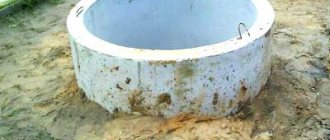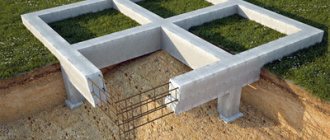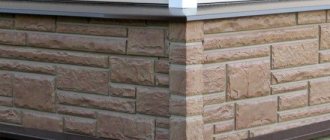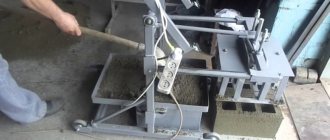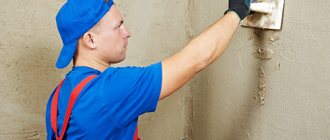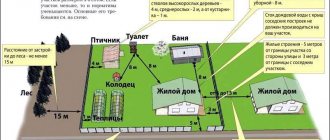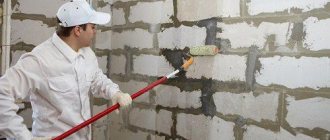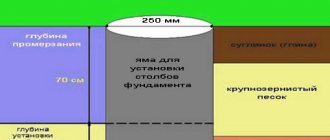A blind area is a covering of a certain width that surrounds the perimeter of the house.
Making a blind area for a home is an important task. This element not only completes the architectural appearance of the building, but also protects the foundation from melt and rain water.
Laying a blind area from paving stones provides the following advantages:
- reliability of waterproofing. The material does not allow moisture to penetrate the soil in the immediate vicinity of the foundation;
- thermal insulation. Due to the presence of several layers, a blind area made of paving stones can provide good protection against freezing. If this is not enough, additional insulation is installed;
- durability. A blind area made of paving slabs does not crack over time, as happens with concrete or asphalt pavement. Stone can last longer and guarantee reliable protection of the building;
- maintainability. If certain sections of the strip around the house are damaged, the paving stone structure makes it possible to replace piece elements without dismantling the entire covering. The work is quite simple to do;
- there is no need for special equipment and tools. To make a strip around a concrete house, you will need to order it from a factory or prepare it yourself a mixture of cement, sand, crushed stone and water. The technology is simple, but if the mixture is ordered at the factory, its transportation by concrete mixer is additionally paid. If the solution is prepared manually, you need containers for mixing large enough volumes, buckets for transferring the solution to the work site, and shovels for leveling. For paving stones this is not necessary;
- a paving stone structure can be used almost immediately. If you decide to pour a concrete blind area, it is important to take into account the strength the concrete gains after 28 days. The formwork can be removed when the strength reaches 70%, which will take at least 2 weeks. In addition, for at least one week, the concrete will require maintenance in the form of moistening every 2-3 hours, otherwise the surface will become covered with cracks. All these activities increase construction time and increase labor intensity;
- a concrete structure requires the installation of formwork from boards; when using paving stones this is not necessary;
- Possibility of access to storm sewerage and drainage. To inspect or repair communications, it is enough to remove several elements of the blind area, and after completion of the work, put them back;
- assortment of colors and shapes of tiles. Laying a blind area around a concrete house does not provide space for imagination and creating unique looks for houses.
What is a building blind area and what is it needed for?
The blind area of the house is done to remove water from the building structure. Excessive amounts of moisture are dangerous even for a foundation made according to all the rules. This becomes especially true in cold weather.
Water expansion coefficient is 1:1.1. That is, it turns into a liquid with a density of 1000 kg/m³ at a temperature below 0° C into a solid state with an indicator of 917 kg/m³. In this case, the pressure becomes so significant that it can deform the metal and destroy concrete and brick. Capillary ground moisture is inevitable, but its impact is not so critical.
The cost of a laying specialist
There are two installation options:
- Turnkey – the company will do all the work itself.
Your task comes down to the fact that you only select the tiles, the pattern of the future blind area and control the progress of the work. All stages of the work will be carried out by the company's specialists. The minimum cost of this option is 1100 – 1300 rubles. If the color of the tile must be two or more colors or it is small in size, then the cost of the work will be a little more expensive - from 1,450 rubles.
- Tiling only .
If you only need to lay tiles, then such a service will cost from 450 rubles . For the installation of one curb, a master charges an average of 70 rubles .
Kinds
Before choosing the type of foundation protection, it is worth familiarizing yourself with the possible options. The selection criteria can be based on the need to use a specific type according to the requirements of the project, the desires of the homeowner, taking into account his aesthetic needs and financial capabilities.
Depending on the material, blind areas are usually divided into the following types:
Concrete blind area:
- A blind area made of concrete is a strong and reliable structure. Subject to compliance with building codes, it provides reliable protection of the foundation from moisture. Disadvantages: rapid loss of appearance, formation of cracks and chips.
- Foundation blind area made of concrete slabs . Unlike the poured design, it has both pros and cons. The advantages include speed and ease of installation. However, the considerable weight of the slabs requires the use of additional equipment during installation.
The disadvantage is also weak points at the joints, so during installation special attention is paid to this aspect. This type of blind area is not recommended for moving soil. It is very difficult to protect the integrity of the structure from cracks.
Blind area made of paving slabs and paving stones:
- Paving stones are a simple and quick way to create a blind area around the house. The lack of tightness is compensated by excellent artistic qualities and an additional waterproofing layer under the topcoat.
- A stone blind area is an excellent option in many cases. Suitable for budget construction, especially if there are no problems with the base material. It is often used to add special aesthetic nuances when constructing exclusive buildings.
- A blind area made of paving slabs around the house - the advantages include the availability and durability of the material, variety of appearance, relatively easy installation method and reasonable price. If the foundation waterproofing technology is not followed, a number of disadvantages appear in this material - the tiles cannot ensure 100 percent drainage of water from the foundation, water penetrates between the seams, the sand and crushed stone gets wet, and the basement part of the foundation begins to absorb moisture.
Soft foundation area
- Soft blind area - construction of this type is available for independent work and, if properly executed, guarantees reliable protection of the house. Efficiency will be higher with good drainage.
- Multilayer soft blind area is a method similar to the above, but supplemented by the use of materials that impart fundamentally new properties.
Important! A blind area is not a replacement for foundation waterproofing! It performs the function of draining water from the base of the building. The level of soil moisture, below several tens of centimeters relative to the level of the site, is stable year-round, even if groundwater does not rise to the bottom of the house during the rainy season. Dry soil around a building does not guarantee the structure's protection from the destructive effects of water.
The types of blind areas noted are the classic and most popular ways of arranging the space around the house. In real life you can also find combined options . It is important to achieve the goal - the structure must be protected from water. Information, knowledge and construction skills will help you choose the best option in each specific case.
In houses on pile or columnar foundations, a blind area is not always made. The climatic features of the region and the design characteristics of the building make this operation impractical. It is better to resolve this issue with professionals who can determine the need for a blind area.
Adviсe
Professional advice will help you correctly install the blind area waterproofing.
- Don't leave waterproofing for later. The blind area must be done immediately during the construction of the building.
- Observe the slope. Try to keep the slope the same throughout the entire perimeter. For this you can use a building level.
- Do not mix concrete and clay.
- To ensure that the insulation does not deform under the weight of the blind area, it is recommended to choose a material with a high density.
- Remember, the blind area does not last forever, it requires care and repair.
- When repairing blind areas, various sealants and mastics are used. The damaged surface is coated to prevent further deformation.
- If there is a large crack or chip on the surface, it is necessary to punch a wedge-shaped hole and fill it with a mixture of concrete. Then cover with film to prevent premature drying.
- The outer layer performs not only a decorative function, but also a protective one. Finishing can be done using paving slabs. Of course, no one forbids you to leave ordinary concrete or crushed stone, but, from the point of view of aesthetics and design, it is better to use decor.
- Numerous reviews on the Internet say that membrane or rolled materials are suitable for waterproofing; they are most often used when used independently.
- You can resort to the advice of the Finns and make a soft blind area.
- For special occasions, when the entire garden around the house is a complete design fantasy, you can use colored crushed stone.
For gardening enthusiasts, the outer layer can be covered with soil and grass or flowers can be planted, the main thing is what is “inside”.
To learn how to properly waterproof a blind area, see the following video.
Criteria for choosing a blind area
The correct blind area around the house is an integrated approach, calculation and compliance with all the rules! When designing a house, the proposed operations are also laid out. The first step is to conduct a soil analysis. For soil prone to noticeable seasonal deformation and displacement, it would be optimal to use a soft blind area.
If for some reason it is decided to build a solid analogue, then the required thickness is calculated and the structure is heavily reinforced. The dimensions of the blind area are determined according to SNiP, the minimum width should be 60 cm, the slope angle is 3-10 degrees.
Advice! In practice, it is very difficult to protect a concrete blind area on soft ground from cracks at the junction with the foundation. There are two ways to ensure the reliability of the design . The first is that the waterproofing layer of the blind area is placed on the foundation before finishing the basement part. The second method is to fix the reinforcing elements in the body of the foundation. A sufficient number of connections is made to obtain a monolithic and reliable structure. Point fixation will not give the desired result. If spoiled, seasonal fluctuations in humidity and temperature will lead to significant movement of elements, which will disrupt the waterproofing of the foundation at the attachment points.
The financial component of the project is also important. The work of pouring concrete and laying paving stones will take a lot of time and money. Soft blind area is much more economical and often no less reliable. In addition, by choosing this type you can save on labor costs. The work is not difficult and you can do it yourself.
The decisive factor in the choice may be the style of the building’s exterior and the surrounding landscape. Often the blind area is performed using the same technique as the paths on the site. Sometimes a project requires the use of a specific material to implement a design idea.
A creative approach to solving this problem is not always associated with high costs. You can get wonderful results with a limited budget. Technical requirements should not suffer in this case.
Filling the seams of paving slabs
Three days after the completion of laying the paving stones, they fill the joints of the pavement with their own hands. To do this, you need to make a dry cement-sand mixture in a ratio of 1:3, which is poured in half-bucket portions onto the blind area tiles. Using a hard broom, sweep the mixture along the plinth around the house, filling the joints of the tiles. After filling all the joints, gently water the surface with water from a garden watering can, just to moisten the dry mixture in the joints.
After a day, the procedure is repeated, but without wetting with water. The mixture should not fill the joints flush with the surface; the joints should be clearly marked. The dry mixture, due to its hygroscopicity, will harden in a week, picking up moisture from the air and the fresh concrete base.
To remove excess roofing material overlap, you need to make an incision around the building on the waterproofing along the edge where the paving stones meet the polystyrene foam of the base. In the same way, excess roofing material is removed from the outside of the curbs.
Do-it-yourself soft blind area, step-by-step instructions on how to do it correctly
The design feature of this type of protection of the base of the house from moisture is its mobility and the absence of solid elements. The method is effective in any climatic region and has won a lot of fans, both among homeowners and builders.
Depending on the design, the hidden blind area is divided into a regular soft blind area and its multilayer version. In the first case, efficiency and simplicity are attractive.
Stages of work:
- The minimum required thickness of the blind area is determined.
- A horizontal level is marked along the perimeter of the building.
- Based on the desired characteristics, width and depth of the blind area, a ditch is made; it is desirable that the upper part of the finished structure be higher than the ground level in its highest part relative to the previously drawn horizontal mark. The width of the ditch is made at least 60 cm. In some cases, this value is increased to a meter or more.
- Clay, which itself is a natural waterproofing agent, is placed and compacted at the bottom of the ditch.
- Then the main protective layer is installed. Film materials of various qualities are used as waterproofing. Focus on the joints of individual parts. Using recommended means, they are connected in such a way as to prevent the penetration of moisture.
- Sand is poured onto the waterproofing layer and distributed evenly. It presses the film and protects it from physical impact, evenly distributing the load.
- The sand layer is covered with crushed stone.
The classic type of economical and least expensive blind area is presented. The budget option can be supplemented with a decorative layer. It is made from available materials - tiles, paving stones, colored crushed stone, etc. There are no difficulties in the work and it is often performed with sufficient quality by people who have minor skills in general construction specialties.
More reliable protection of the house will be provided by a multi-layer soft blind area. Its installation differs from classical technology by the use of modern materials. The main one is geotextiles .
Its main function is to stabilize layers, reduce mobility and prevent mixing of fractions. The peculiarity of geotextiles is that they allow water to pass through perfectly and are not clogged with small suspended particles.
The material is laid after leveling the sand layer. It securely holds the crushed stone and prevents it from penetrating into the sand.
Sometimes homeowners stop at this stage. However, the full cycle of laying a multilayer blind area requires the presence of a decorative layer . In this case, another layer of geotextile is laid on top of the crushed stone. Then they install tiles, paving stones or other selected material.
As an additional measure to protect the building from freezing, an insulating layer . The best material for this is polystyrene foam. It is sold in sheets. Easy to process. In some cases, the insulating layer is applied by spraying, but this is significantly more expensive, although much more effective.
Required materials for installation
- elements of paving stones and curb stones;
- waterproofing material (films, roofing felt, linochrome, waterproofing);
- clay for hydraulic lock;
- medium or coarse sand to level the base;
- crushed stone or gravel (along with sand, it provides a drainage layer, levels the base and improves soil characteristics);
- geotextiles to prevent debris from entering the drainage system, which will lead to clogging;
- cement-sand mortar for filling the joints of paving stone elements.
conclusions
When choosing the type of blind area, you should know that their functions are the same and the primary importance is not the chosen method of protecting the foundation, but compliance with norms and rules, technological sequence and compliance of materials with requirements.
Carefully done work in a simple way will last no less than an expensive project using prestigious materials, confirming the everyday rule - money is not always the decisive factor for success.

